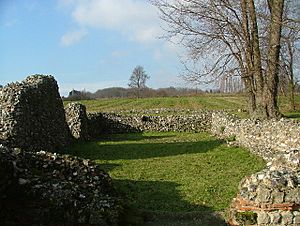Faversham Stone Chapel facts for kids
The Faversham Stone Chapel, also called Our Lady of Elwarton, is a very old chapel. It was built during the Middle Ages right on top of an even older Roman building. This Roman building might have been a special tomb or shrine. The chapel is found near the town of Faversham in Kent, England. Experts believe this area was once a Roman town called Durolevum. It is the only chapel in England that includes parts of an ancient Roman building.
Contents
Roman History of Faversham
A Roman Town in Kent
Even though the chapel is now in a quiet, rural area, it was once a busy place during Roman times. There might have been a Roman army camp nearby at a place called Judd Hill. People have found many Roman objects there, suggesting a large building, possibly a fort.
A Roman cemetery, where about 387 people were buried, is also located close to the chapel. Many Roman coins and other items have been found in the area. In 2012, archaeologists discovered a huge Roman theatre in Faversham. This theatre was shaped like a cockpit and could hold up to 12,000 people! It is thought to be the first theatre of its kind built in Britain. All these discoveries make researchers believe that Faversham was the Roman town of Durolevum. This town was even mentioned in an ancient Roman travel guide called the Antonine Itinerary.
The Ancient Roman Building
The Roman building under the chapel is roughly square. Its walls are about 17 feet long and 3 feet thick. The Romans built these walls using a special technique. They used a foundation of flint stones. Then, they layered blocks of a soft stone called tufa with layers of red bricks.
The building had no windows and a curved roof, like a tunnel. Its main door was made from a single large stone called greensand. The bottom part of this doorway is still there today. The floor was originally made of a very strong, waterproof concrete called opus signinum. This concrete was made from crushed tiles or bricks, which gave it a reddish color. The walls inside were covered with plaster and painted red. They might have even had beautiful pictures painted on them.
Experts think this Roman building was a mausoleum, which is a grand tomb. However, no burials have been found inside, so they can't be completely sure. Since there isn't a large Roman house (villa) or a cemetery right next to it, some people think it might have been a Roman temple or a small Christian shrine instead.
The Medieval Chapel
After the Roman building became old and broken, it's possible that a wooden Saxon church was built on the site. Later, during the Middle Ages, a new church made of flint stones was built over the Roman ruins. The medieval builders used the strong Roman walls as the main part of their church, called the chancel. The main seating area, called the nave, was built to the west of this.
In the 13th century, the nave and chancel were made bigger. Strong supports called buttresses were added to one side of the church. You can still see parts of the green sandstone door frames from the Roman building used in these buttresses. By 1511, reports said the church was falling apart. It seems to have been completely left empty by the year 1600.
Today, the chapel is recognized as an ancient monument. This means it is a very important historical site that is protected.


